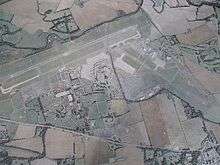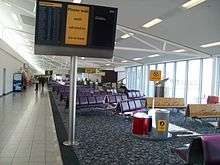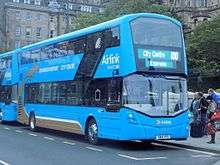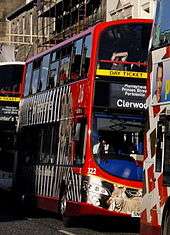Edinburgh Airport
| Edinburgh Airport | |||||||||||||||
|---|---|---|---|---|---|---|---|---|---|---|---|---|---|---|---|
 | |||||||||||||||
 | |||||||||||||||
| Summary | |||||||||||||||
| Airport type | Public | ||||||||||||||
| Owner | Global Infrastructure Partners | ||||||||||||||
| Operator | Edinburgh Airport Ltd. | ||||||||||||||
| Serves | Edinburgh, Lothian, Fife, the Scottish Borders and Central Scotland | ||||||||||||||
| Location | Ingliston, United Kingdom | ||||||||||||||
| Elevation AMSL | 136 ft / 41 m | ||||||||||||||
| Coordinates | 55°57′00″N 003°22′21″W / 55.95000°N 3.37250°WCoordinates: 55°57′00″N 003°22′21″W / 55.95000°N 3.37250°W | ||||||||||||||
| Website | edinburghairport.com | ||||||||||||||
| Map | |||||||||||||||
 EGPH Location in Edinburgh | |||||||||||||||
| Runways | |||||||||||||||
| |||||||||||||||
| Statistics (2016) | |||||||||||||||
| |||||||||||||||
Edinburgh Airport (Scottish Gaelic: Port-adhair Dhùn Èideann) (IATA: EDI, ICAO: EGPH) is an airport located in the Ingliston area of the City of Edinburgh, Scotland. It was the busiest airport in Scotland in 2016, handling over 12.3 million passengers in that year, an increase of 11.1% compared with 2015. It was also the sixth-busiest airport in the UK by total passengers in 2016.[2] It is located 5 NM (9.3 km; 5.8 mi)[1] west of the city centre, just off the M8 and M9 motorways. It is owned and operated by Global Infrastructure Partners, who are also the majority shareholder and lead the management of Gatwick Airport.[3] The airport has two runways and one passenger terminal, and employs about 2,500 people.
History
Early years
Turnhouse Aerodrome was the most northerly British air defence base in World War I used by the Royal Flying Corps. The small base opened in 1916[4] and it was used to house the 603 (City of Edinburgh) Squadron from 1925, which consisted of DH 9As, Westland Wapitis, Hawker Harts, and Hawker Hind light bombers. All the aircraft used a grass air strip.
In 1918 the Royal Air Force was formed and the airfield was named RAF Turnhouse and ownership transferred to the Ministry of Defence.
When the Second World War broke out, RAF Fighter Command took control over the airfield and a runway of 3,900 ft (1,189 m) was paved to handle the Supermarine Spitfire. During the Battle of Britain, No.3 Squadron RAF3, 65, and 141 Squadrons were present at the airbase.
Post World War II
When the war ended the airfield remained under military control, but by the late 1940s the first commercial services were launched. In 1947, British European Airways started a service between Edinburgh and London using Vickers Vikings followed by the Viscount and Vanguard series.
In 1952 the runway was extended to 6000 ft to handle the Vampire FB5s operated by the resident 603 Squadron; and an aircraft carrier Catcher Net (never used) was installed to protect traffic on the adjacent A9 road. In 1956 a new passenger terminal was built to provide an improved commercial service; five years later it was extended. After the disbandment of 603 Squadron in March 1957, the Ministry of Defence transferred ownership to the Ministry of Aviation in 1960 to offer improved commercial service to the airport. Flying was temporarily diverted to East Fortune, which had its runway extended to accommodate the airliners of the period.
BAA Ownership 1971 to 2012


The British Airports Authority took over ownership of the airport on 1 April 1971 at a time when the original terminal building was running at about eight times its design capacity. Immediate improvements to the terminal were cosmetic, such as extra seating and TV monitors for flight information, and it took two years for plans to be proposed for a completely new terminal and runway redesign. A public consultation on planning started in November 1971 and ended in February 1972. Initial stages of the redevelopment began in June 1973; they included a diversion of the River Almond. Work on the new terminal building, designed by Sir Robert Matthew, started in March 1975, and the building was officially opened by Her Majesty the Queen on 27 May 1977, opening to the public two days later.
Although the original main runway 13/31 (which is now 12/30) served the airport well, its alignment (NW-SE) had the disadvantage of suffering from severe crosswinds, and the other two minor runways were very short and could not be readily extended, so movements were transferred to a new runway (07/25, which has since become 06/24) in an addition completely outside the original airfield boundary. This runway, completed in 1977, is 2,556 m (8,386 ft) in length, and was able to take all modern airliners including Concorde. A new terminal was built alongside the runway to cater for the additional traffic. The old terminal and hangars were converted into a cargo centre.
International service from Edinburgh began in 1962 with a direct service to Dublin, but for many years international flights were charter and private only. This started to change during the late 1970s, with direct services to continental Europe (Amsterdam, 1975). By the mid-1980s direct routes included Paris, Düsseldorf, Brussels, Frankfurt and Copenhagen, but until the Open Skies Act in 1990, all transatlantic flights had to land first at Prestwick, with very few exceptions. By the time BAA had been privatised in 1987, Edinburgh Airport handled over 1.8 million passengers each year; compared to the 681,000 passengers handled in 1971 when BAA first took control of the airport.[5]
RAF Turnhouse was operational near the passenger terminal of the airport for all of the post war period, but was finally closed in 1997.[6]
Since the original terminal upgrade in 1977, there have been major reconstructions, including extensions of the two passenger terminal aprons and a major expansion of car parking facilities, including a multi-storey car park in 2004. In 2005, a new 57-metre-tall (187 ft) air traffic control tower was completed at a cost of £10m. An extension to the terminal called the South East Pier opened in September 2006. This extension initially added six gates on a new pier to the south-east of the original building. A further four gates were added to the South East Pier at the end of 2008.
On 19 October 2011, BAA Limited announced its intention to sell the airport, following a decision by the UK's Competition Commission requiring BAA to sell either Glasgow Airport or Edinburgh Airport.[7] BAA announced on 23 April 2012 that it had sold Edinburgh Airport to Global Infrastructure Partners for a price of £807.2 million.[8]
Expansion
In 2013, a further extension to the passenger terminal was announced, taking the terminal building up to the Edinburgh Airport tram stop. The opening of the Edinburgh Trams in May 2014 created the first rail connection to Edinburgh Airport. Whilst the number of passengers has increased, the number of flights actually decreased in 2014 due to planes operating at higher capacity.[9] Passenger traffic at Edinburgh Airport reached a record level in 2015 with over 11.1 million passengers[10] and over 109,000 aircraft movements.[2] The terminal building is currently being expanded with an investment of £40m. A new £25m expansion project involving the construction of a new 6,000m² building, housing a security hall and retail areas, is also currently under way at the airport. On 23 February 2016, Ryanair announced a growth of 20%, bringing the airline's annual passenger capacity at Edinburgh Airport to 2.5 million. This was coupled with the news of six new services to Ryanair's winter schedule from Edinburgh, in addition to more services on its popular European destinations. In February 2016, consultancy firm Biggar Economics announced that Edinburgh Airport contributes almost £1 billion to the Scottish economy every year.[11]
Airlines and destinations
Passenger
The following airlines operate regular scheduled and charter flights to and from Edinburgh:[12]
Cargo
| Airlines | Destinations |
|---|---|
| ASL Airlines Belgium | East Midlands, Liège |
| DHL Aviation | Leipzig/Halle |
| Royal Mail operated by Jet2.com | East Midlands, London–Stansted |
| Royal Mail operated by Loganair | Aberdeen, Inverness |
| Royal Mail operated by Titan Airways | London–Stansted |
| UPS Airlines operated by Star Air | Cologne/Bonn, East Midlands |
Statistics
Passenger numbers
| Edinburgh Airport Passenger Totals 1985–2016 (millions) |
|---|
 |
| Source: These statistics are combined BAA and CAA figures pre-1996, Edinburgh Airport: A History; McCloskey, Keith. Post 1996: United Kingdom Civil Aviation Authority[2] |
| Number of Passengers[nb 1] | Number of Movements[nb 2] | |
|---|---|---|
| 1985 | 1,578,000 | 36,926 |
| 1986 | 1,651,000 | 36,596 |
| 1987 | 1,852,000 | 39,603 |
| 1988 | 2,080,000 | 40,664 |
| 1989 | 2,369,000 | 47,100 |
| 1990 | 2,495,000 | 47,900 |
| 1991 | 2,343,000 | 49,700 |
| 1992 | 2,539,000 | 56,400 |
| 1993 | 2,721,000 | 58,800 |
| 1994 | 3,001,000 | 61,100 |
| 1995 | 3,280,000 | 64,000 |
| 1996 | 3,810,000 | 68,800 |
| 1997 | 4,214,919 | 99,352 |
| 1998 | 4,588,507 | 100,134 |
| 1999 | 5,119,258 | 101,226 |
| 2000 | 5,519,372 | 102,393 |
| 2001 | 6,067,333 | 112,361 |
| 2002 | 6,930,649 | 118,416 |
| 2003 | 7,481,454 | 118,943 |
| 2004 | 8,017,547 | 125,317 |
| 2005 | 8,456,739 | 127,122 |
| 2006 | 8,611,345 | 126,914 |
| 2007 | 9,047,558 | 128,172 |
| 2008 | 9,006,702 | 125,550 |
| 2009 | 9,049,355 | 115,969 |
| 2010 | 8,596,715 | 108,997 |
| 2011 | 9,385,245 | 113,357 |
| 2012 | 9,195,061 | 110,288 |
| 2013 | 9,775,443 | 111,736 |
| 2014 | 10,160,004 | 109,545 |
| 2015 | 11,114,587 | 115,286 |
| 2016 | 12,348,425 | 122,220 |
Busiest routes
| Rank | Airport | Total passengers | Change 2015 / 16 |
|---|---|---|---|
| 1 | | 1,053,382 | |
| 2 | | 836,860 | |
| 3 | | 700,064 | |
| 4 | | 651,034 | |
| 5 | | 597,472 | |
| 6 | | 528,029 | |
| 7 | | 381,945 | |
| 8 | | 308,612 | |
| 9 | | 274,292 | |
| 10 | | 272,503 | |
| 11 | | 267,279 | |
| 12 | | 250,778 | |
| 13 | | 216,647 | |
| 14 | | 206,991 | |
| 15 | | 198,501 | |
| 16 | | 197,174 | |
| 17 | | 185,545 | |
| 18 | | 183,518 | |
| 19 | | 183,032 | |
| 20 | | 181,033 |
Access and ground transport
Road

The airport lies on the A8 Glasgow–Edinburgh road, and can be easily reached by the M8 (from Glasgow) and the M9 (from Stirling). The airport is also within easy access from the M90 motorway (from Perth) via the Forth Road Bridge.
Lothian Buses provide public transportation to the airport with the Airlink 100 express bus from Edinburgh city centre,[42] as well as the number 35 direct to Ocean Terminal and N22 with the same destination but alternative route. From 23rd April 2017, a second daytime route, service 200, from the airport to Ocean Terminal was introduced travelling via northern Edinburgh suburbs. This service is branded 'Skylink' and uses five specially branded vehicles for the operation. Special fares are in operation, similar to the Airlink 100. Additionally, Stagecoach operates the newly formed JET express bus service, previously AirDirect 747 between the airport and Inverkeithing railway station and Ferrytoll Park and Ride in Fife.[43]
Tram
The airport is served by Edinburgh Trams, a light rail link from the terminal to Edinburgh York Place. The system runs from Edinburgh Airport tram stop and travels across the western suburbs of Edinburgh on a segregated track; when the trams reach Haymarket railway station they switch to street-running mode and travel through the city along Princes Street. Edinburgh Trams began operation on 31 May 2014.[44][45]
Train
The airport lies very close to the Fife Circle and the Edinburgh–Glasgow railway lines, and Edinburgh Gateway station was built on the Fife Circle Line, providing an interchange with airport tram services to serve the airport. This station and upgrades were finally approved by the Scottish Parliament in 2012[46] and the station opened on 11 December 2016.[47] It replaced the more expensive Edinburgh Airport Rail Link project which was cancelled in 2007 after a change in Government.[48] The tram line also connects the airport to the nearby Edinburgh Park railway station on the Edinburgh–Glasgow line.[49]
Accidents and incidents
On 27 February 2001, a Loganair Shorts 360 (G-BNMT) operating a Royal Mail flight to Belfast, crashed into the Firth of Forth shortly after taking off from Edinburgh at 1730 GMT. Both crew members were killed, but there were no passengers on board. A fatal accident inquiry later blamed a buildup of slush in the aircraft's engines before the crash. A protective covering had not been fitted to the engine intakes while the aircraft was parked at Edinburgh for several hours in heavy snow.[50][51]
Accolades
- 2011 – 2nd Best Airport in Europe of the Airport Service Quality Awards by Airports Council International[52]
Notes
References
- 1 2 "NATS – AIS – Home". ead-it.com.
- 1 2 3 4 "Aircraft and passenger traffic data from UK airports". UK Civil Aviation Authority. 3 March 2017. Retrieved 14 March 2017.
- ↑ "Global Infrastructure Partners". global-infra.com.
- ↑ "EDI Facts and figures". '"Edinburgh Airport. Retrieved 1 June 2016.
- ↑ Edinburgh Airport: A History; McCloskey, Keith; 2006
- ↑ "Site Record for Edinburgh, RAF Turnhouse". Canmore. RCAHMS. Retrieved 8 January 2013.
- ↑ "Heathrow: About us – Heathrow". baa.com.
- ↑ Heathrow. "Press Releases". baa.com.
- ↑ ^ CAA: UK Annual Airport Statistics
- ↑ "Edinburgh Airport hails record year". BBC News. 11 January 2016.
- ↑ "Edinburgh Airport Brings in the Bucks". Airport Parking Market. 26 April 2016.
- ↑ edinburghairport.com - Flight Timetable retrieved 23 November 2016
- ↑ "Afgange" (in Danish). Hans Christian Andersen Airport. Retrieved 17 April 2017.
- ↑ https://www.easyjet.com/en
- ↑ https://seenews.com/news/easyjet-to-launch-winter-flights-from-bulgarias-sofia-to-edinburgh-578131
- ↑ https://www.flybe.com/featured-routes/
- ↑ http://www.bbc.co.uk/news/world-europe-isle-of-man-39444973
- ↑ http://www.bbc.co.uk/news/uk-scotland-highlands-islands-38055208
- ↑ http://www.jet2.com/
- ↑ http://www.jet2.com/
- ↑ http://www.jet2.com/
- ↑ http://www.therouteshop.com/profiles/edinburgh-airport/
- ↑ http://www.bbc.co.uk/news/world-europe-isle-of-man-39444973
- ↑ http://www.loganair.co.uk/loganair/press-office/256/scotland%26%23039%3bs-airline-spreads-its-wings
- ↑ http://www.wheretoskiandsnowboard.com/news/powdair-to-fly-from-uk-regions-to-sion/
- ↑ http://www.lenouvelliste.ch/articles/valais/valais-central/sion-sept-nouvelles-destinations-pour-l-aeroport-636444%20%20
- ↑ "Ryanair W17 new routes as of 05MAR17". Routesonline. Retrieved 5 March 2017.
- ↑ "Ryanair W17 new routes as of 05MAR17". Routesonline. Retrieved 5 March 2017.
- ↑ http://verkeersbureaus.info/nieuws/2017/07/06/98624-reactie-eindhoven-airport-op-persconferentie-ryanair-6-juli-2017/
- ↑ https://www.ryanair.com/gb/en/
- ↑ "Ryanair W17 new routes as of 05MAR17". Routesonline. Retrieved 5 March 2017.
- ↑ "Ryanair W17 new routes as of 05MAR17". Routesonline. Retrieved 5 March 2017.
- ↑ "Ryanair W17 new routes as of 05MAR17". Routesonline. Retrieved 5 March 2017.
- ↑ "Ryanair W17 new routes as of 05MAR17". Routesonline. Retrieved 5 March 2017.
- ↑ "Ryanair W17 new routes as of 05MAR17". Routesonline. Retrieved 5 March 2017.
- ↑ "Ryanair W17 new routes as of 05MAR17". Routesonline. Retrieved 5 March 2017.
- ↑ https://www.flysas.com/en/Generic/Services/Timetable/
- ↑ http://www.crystalski.co.uk
- ↑ http://www.vueling.com/en/book-your-flight/flight-timetables
- ↑ http://www.vueling.com/en/book-your-flight/flight-timetables
- ↑ "Airport Data 2016". UK Civil Aviation Authority. 3 March 2017. Tables 12.1(XLS) and 12.2 (XLS). Retrieved 16 March 2017.
- ↑ "Edinburgh Airport – City Centre frequent express shuttle". Lothian Buses. Retrieved 20 January 2010.
- ↑ "Airdirect 747". Stagecoach Group. Retrieved 20 January 2010.
- ↑ "Edinburgh's trams roll into action". BBC News.
- ↑ "Route map". Edinburgh Trams. 2009. Archived from the original on 18 September 2009. Retrieved 20 January 2010.
- ↑ Stevenson, Stewart (27 September 2007). "Edinburgh Airport Rail Link". Scottish Parliament. Retrieved 12 January 2010.
- ↑ "New Edinburgh Gateway interchange opens in capital". Retrieved 17 December 2016.
- ↑ "It's £30m down the drain". The Scotsman. Edinburgh. 27 September 2007. Archived from the original on 5 June 2011. Retrieved 20 January 2010.
- ↑ "Trains". Edinburgh Airport. Retrieved 9 August 2017.
- ↑ Scotsman: Pilots praised as sheriff confirms snow caused crash, 13 November 2003
- ↑ Harro Ranter (27 February 2001). "ASN Aircraft accident Shorts 360-100 G-BNMT Granton Harbour". aviation-safety.net.
- ↑ "ASQ Award for Best Airport in Europe" Airports Council International. 14 February 2012. Retrieved 13 April 2012
External links
![]() Media related to Edinburgh Airport at Wikimedia Commons
Media related to Edinburgh Airport at Wikimedia Commons
- Official website
- Edinburgh Airport Consultative Committee
- EDINBURGH AIRPORT, TURNHOUSE (1971) (archive film from the National Library of Scotland: SCOTTISH SCREEN ARCHIVE)
- Current weather for EGPH at NOAA/NWS
- Accident history for EDI at Aviation Safety Network

